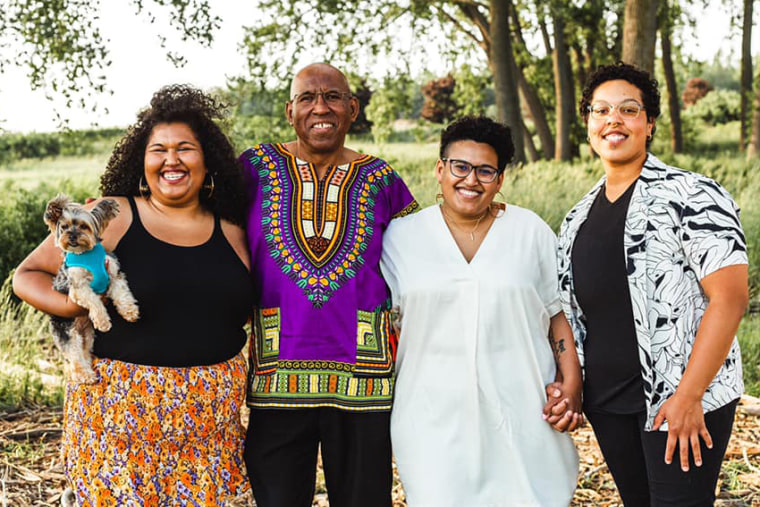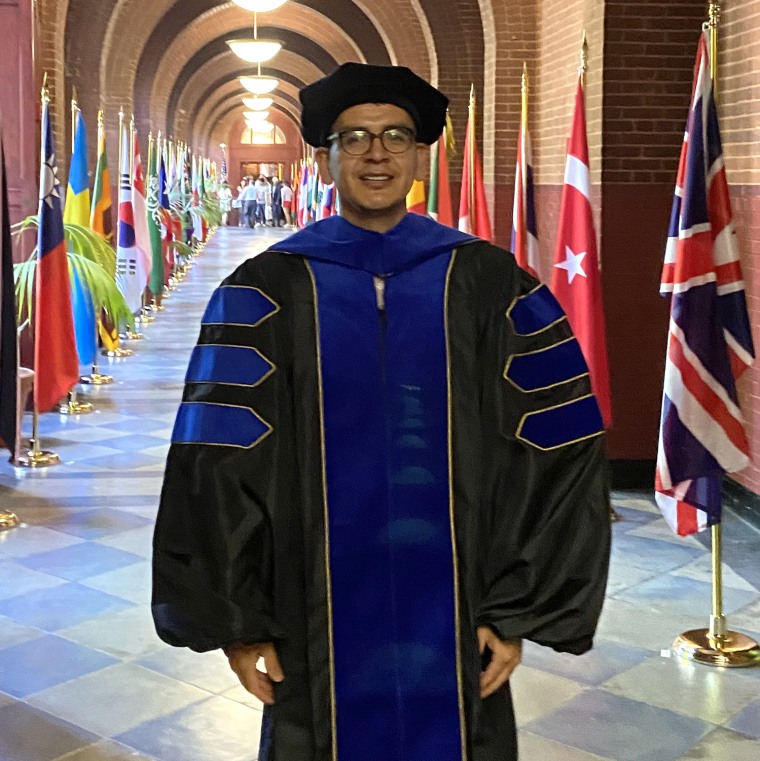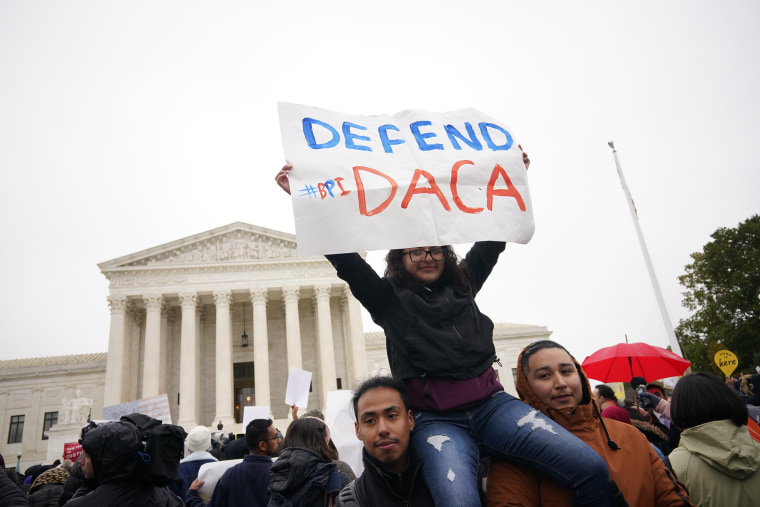As a young girl raised in the U.S. without legal status, Karla Mendoza Arana learned how to accept a limited future.
Mendoza Arana's dad was a chemical engineer in Peru and her mother was a pre-school teacher; both were pastors. But when they moved to the U.S., the couple, who were undocumented, worked at a warehouse, later switching to housekeeping.
For Mendoza Arana, her prospects changed when in 2012 President Barack Obama implemented the Deferred Action for Childhood Arrivals program, DACA, allowing hundreds of thousands of young undocumented immigrants who were largely raised in the U.S. to apply to work and study in the U.S. without fear of being deported.

“I just remember all of us were instantly sobbing. We knew, especially my sister and I, our lives would be changing,” Mendoza Arana, 32, originally from Lima, Peru, told NBC News.
There is mounting evidence that, in its decade of existence, DACA has done on a smaller scale what the GI Bill did for returning veterans — it elevated a group of people into the middle class, thus conferring advantages to parents, children, siblings and communities.
“The 10-year, long view of DACA is really the story of young people taking advantage of a policy to find on-ramps to education, job level programs and certificates, who were able to use that early entry to get their foot in the door in jobs and careers as stepping stones to really launch themselves,” said Roberto Gonzales, professor of sociology and education at the University of Pennsylvania who has been tracking the lives of more than 500 DACA recipients over the last decade after studying thousands of undocumented young Americans.
“It’s indisputably the most successful policy of immigrant integration since the 1980s — it is really the American Dream put into reality at a scale of hundreds of thousands,” Gonzales said.
Even so, DACA remains in jeopardy, with a Texas Republican-led challenge of the policy now in the 5th Circuit Court of Appeals and a court decision in that case blocking new DACA applicants from getting approved.
The program already is not available for many. To be eligible, undocumented young people had to have arrived in the country before June 15, 2007. This will be the first year that an overwhelming majority of the estimated 100,000 undocumented high school graduates are ineligible for DACA, according to FWD.us, a progressive immigration lobbying group.
For Mendoza Arana, a series of firsts followed her DACA approval. She got her first job at 23; previously, she had only been able to work in internships. For the first time, she had medical benefits through her job, and saw a dentist for the first time in over a decade.
And she has a driver’s license. “It’s been 10 years and to this day I look at it and I’m like, I can’t believe I am holding this in my hands,” Mendoza Arana said.
The DACA incentive
Some have argued that advocates and media take a rosy look at DACA focusing on the success stories. But along with Gonzales’ findings of improved lives among the recipients he’s tracked, a trio of economists found direct impact on high school retention.
“We find that DACA significantly increased high school attendance and high school graduation rates,” the economists stated in a 2020 study published in the American Economic Journal.
Before DACA, Gonzales detailed in his book “Lives in Limbo” that undocumented young people's lack of legal status precluded any real educational and career advancement.
“Prior to DACA, going to college was a big risk,” Gonzales said, “not worth it for those undocumented young people who could see no link between education and the types of jobs they could obtain.”
“With DACA, it’s allowed them to obtain employment that matches their credentials in the field of their choice, and that is huge," he said. “They’re living solidly middle-class lifestyles and have grown into their status, it’s really remarkable,” Gonzales said.
In a 2017 analysis of the DACA population, the Migration Policy Institute found that DACA recipients were almost as likely as U.S. adults in the 15-32 age group to be enrolled in college — 18 percent and 20 percent respectively.
Also, 40 percent of recipients were enrolled in secondary education, but not college, and 20 percent were still in secondary school.
For many families, it’s meant breaking the cycle of poverty and opening up new opportunities.
After the program was implemented, the health care field has seen an uptick in Latinos — and it became evident during Covid.
Gonzales gave the example of several DACA recipients he's interviewed over the years. With DACA, they started out as Certified Nursing Assistants, doing basic yet necessary hospital work — “you’re changing bed pans". They obtained their associate’s degrees while they worked, then got a bachelor’s and then became registered nurses; some went on to get their master’s degrees.
DACA recipients earning north of $75,000 a year are helping parents financially, putting their children in quality day care programs, moving to better neighborhoods and becoming more active in their communities, the research has shown.
The gains don't apply just to those who went to college. For those who were older and already in the workforce, DACA made it possible for them to seek professional licenses, leading to better jobs.
Alma Benito, 22, was working in the fields of the Coachella Valley alongside her parents when Obama implemented DACA. Up to that point, “there weren’t many opportunities. I couldn’t just apply to a job. I didn’t have a Social Security number,” Benito said.
After getting DACA in 2015, she found better work and attended California State University, Bakersfield. When the pandemic forced her to pause that and return home to help her family, she was able to borrow $1,000 to help cover the family’s costs.
She is a staff member at the TODEC Legal Center, a Latino legal advocacy group.
When Benito’s sister became eligible for DACA, the Trump administration stopped taking new applications. Unable to get a job good enough to pay for college, her sister still works in the fields with her parents.
For Abel Cruz Flores, migrating to Parkland, Oregon, as a 15-year-old from the remote town of La Parota in Mexico, was a culture shock. He attended River Valley High School and dropped out after two weeks because of the language barrier. He returned to working in the fields picking pears, cherries and blueberries.

A year later, with some nudging from his sister, he re-enrolled in high school. Last summer, he earned his doctorate from Georgetown University and is now a university professor.
As one of the early recipients of DACA, he sought out graduate programs and landed at the University of Arizona’s Hispanic linguistics program, where he received a stipend, health insurance, had his tuition paid for and was paid to teach.
“DACA is the fundamental key to open the door to achieve those academic merits for higher salary,” said Cruz Flores, an assistant professor in the Department of Modern Languages and Literatures at Santa Clara University in California.
'Not enough'
Massachusetts State Rep. Danillo Sena, a Democrat, recalls going to Washington, D.C., as a high school student to advocate for the DREAM Act, legislation aimed at providing a path to legal status for young immigrants.
He was undocumented, having moved to the U.S. from Timbaúba, Brazil at 14 with his family. Obama used executive authority to create DACA after Congress’ repeated failure to pass the DREAM Act, or versions of it.
Sena secured his DACA benefit soon after it was announced. He completed his bachelor’s degree studies in political science in 2019 at University of Massachusetts, Amherst. He worked for six years for Massachusetts state Sen. James Eldridge, a Democrat. Along the way, in 2018, sponsored by his spouse, he became a U.S. citizen and in June 2020, won a special election to the Massachusetts Legislature.
Now 35, he is seeking re-election.
DACA “certainly has helped me to be where I am today, for sure,” Sena said. “But just giving people DACA status is not enough. There needs to be a pathway with citizenship."
DACA was always meant to be temporary, with the goal of congressional legislation setting DACA recipients and other eligible undocumented Americans on a path to legal status.
“Ultimately, as great as this policy is, it’s by nature temporary and partial and not meant to be longstanding policy,” Gonzales said. “Many programs tied to DACA status, if it’s ultimately revoked, they go away.”
In the last 10 years, previous bipartisan plans for immigration legislation have been shelved, with Republicans eschewing attempts at immigrant integration and focusing on border control.
DACA recipients live with two realities — the regular renewal of DACA and the possibility that DACA is taken from them, which could even mean having to move to another country to start over.
“What does it mean to have hundreds of thousands in perpetual limbo submitting documents and paying fees to submit their status and continue to prove they're worthy Americans?” Gonzales said. “They’ve proven it in ways no one else has had to."
Follow NBC Latino on Facebook, Twitter and Instagram.




